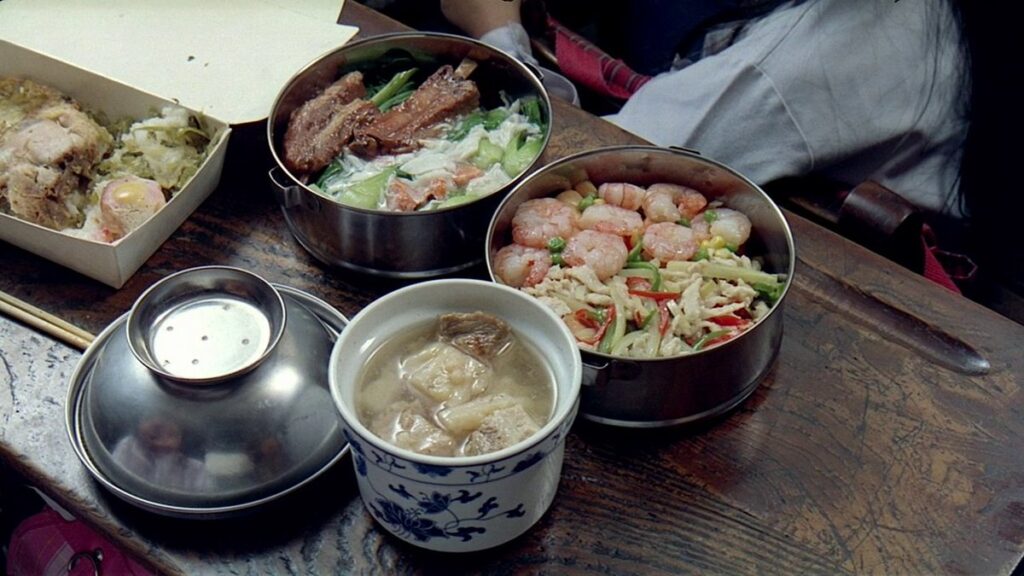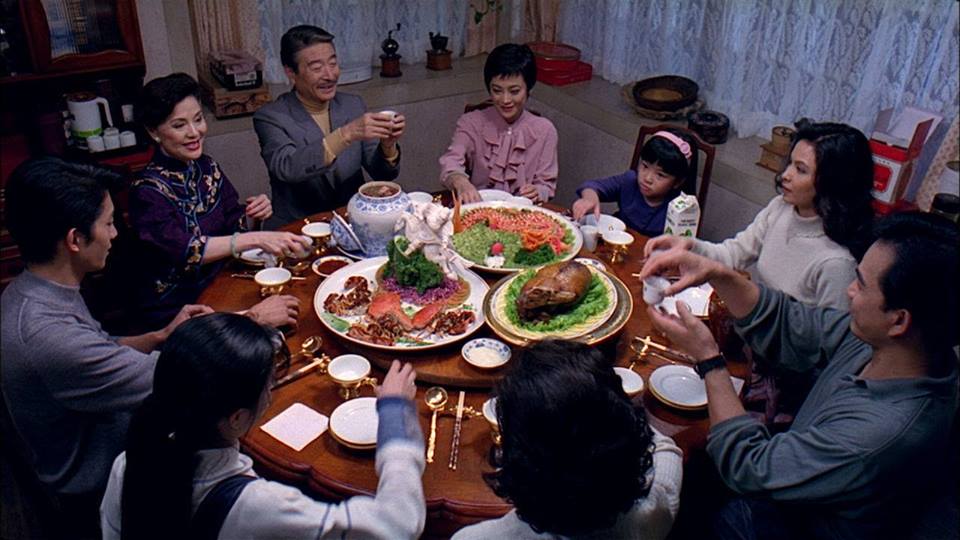Directed by Ang Lee, written by Ang Lee, James Schamus, and Hui-Ling Wang
Since the introduction of sound, cinema has competed with opera as the exemplar of Gesamtkunstwerk, the total art form. Both encompass the visual, aural, spatial, and the pathetic. With experiments like Sensurround and Odorama, the movies have tried incorporating the haptic and olfactory—that these innovations did not endure is testament to their ephemeral novelty. As for me, I’d rather “feel” through the stirring of emotions (the original meaning of pathetic, as used above) than through a kludgy contraption shaking my seat.
The best movies stir your emotions through compelling acting, incisive writing, artful visuals, and masterful music and sound design. To this list of sensory stimulations, why can’t we add smells and tastes? We can! We just have to use a little thing called memory. And it turns out that memory is more powerful than Odorama.
The best food movies rely on memory. Is there any clearer example of this than the turning point of Ratatouille? You may have never tasted the dish, but you know the comfort of mom’s cooking. The joie de vivre of The Hundred Foot Journey, the frustrated desire of Like Water for Chocolate, the celebration of Big Night, and the prodigal passion of The Taste of Things gamble not that you know the actual flavors depicted, but that you understand what the food means. So it goes with one of the best food movies, Ang Lee’s Eat Drink Man Woman.
In that movie, a master chef struggles to relate to his three daughters. The youngest, Jia-Ning, works at Wendy’s and the oldest, Jia-Jen, lives a flavorless, prudish life. Only the middle daughter, Jia-Chien, seems to have inherited her father’s culinary sensibilities. But she’s an upwardly mobile executive who is ready to move out of the family home as soon as she gets her promotion. Chef Chu wants to keep the family together, but he sees the modern age is upon them, and his time is past.
This is the same struggle portrayed in Lee’s Pushing Hands and The Wedding Banquet. Si-Hung Lung portrays the bemused father in all three films—one who sadly has outlived his usefulness. Like the other two films, Eat Drink Man Woman is a comedy, so there are broad strokes that cover uncomfortable truths. As mentioned, Jia-Ning serves fast food and strikes up a heedless romance with a Dostoevsky-loving photographer. Jia-Jen has embraced a dour, purse-lipped brand of Christianity. Jia-Chien’s rebellion is represented by power suits and executive meetings. So Chu must take comfort in the middle aged divorcee next door and her young daughter who so appreciates Chu’s cooking, she takes orders at her grade school for the next day’s menu. Chu’s daughters are also trying to fix their widowed father up with the divorcee’s mother—because, you know, they’re both old. The paths that all the characters take are poignant, relevant, and full of surprises. I love Eat Drink Man Woman because it doesn’t stand on laborious set-up. Situations change on a dime—I heard several gasps from the audience at certain revelations. These surprises are a delight, like biting into a filled bao.

We of course sympathize with the young adult daughters, but our deepest feelings go with Chu. A close friend’s death and a hospital visit suggest his time may be short. Where The Wedding Banquet ends with a heart-rending shot that suggests the father’s crossing over into another world, Eat Drink Man Woman follows a more hopeful arc. Chu does have a purpose, illustrated by a pivotal scene. Chu insists on preparing sumptuous feasts for his daughters, who only criticize his cooking. Then he’s called by his old boss, the manager of the Grand Hotel in Taipei. A banquet is falling apart, and only Chu can save it! Lee’s early camera work is typically staid and simple (no doubt limited by his indie budgets), but as Chu enters the kitchen, a complex and energetic tracking shot follows him through the chaos—he is the master here, and as he examines the failed opening course, he quickly devises a way to rescue the menu.
And what a menu! Peking duck, winter melon soup, whole fried fish, chicken with mushrooms, char siu spare ribs, cucumber salad, and a rainbow of other Chinese dishes explode on screen with color and sensuousness. You won’t find these dishes at Panda Express, but some were regular occurrences at the Ching dinner table. I know their flavors, but that knowledge doesn’t matter here. It’s the artistry—the care with which Chu carves the watermelon and chops the vegetables—that provides the sensory experience. Authentic Chinese cuisine has many tastes Westerners find off-putting, relying as it does on unfamiliar and fermented ingredients. Instead, an American or a Brit or a Spaniard can watch the lovingly photographed cooking scenes in Eat Drink Man Woman and imagine the savory, sweet flavors they associate with the food.
Sorry, I knew I would fixate on the food. But how could anyone not? Food remembers, food hopes, and Chu’s loving preparations are both his memory of the past and hope for his children. They are what he does best. Ang Lee has a stunning way with final shots. They always bring me to tears (okay, maybe not in Hulk) because they evoke something core to our being—love, death, wistfulness. In Eat Drink Man Woman the final shot wraps the tumultuous events up in a dumpling wrapper and skillfully pinches the top closed. There are wishes fulfilled and promises kept. And maybe an old man finds he still has much to live for.
P.S.: When you see this movie, make sure you have ready access to a Chinese meal, hopefully something better than Panda Express.
P.P.S.: Eat Drink Man Woman was remade from the same script as Tortilla Soup, transplanting the ethnic setting to a Mexican-American one. While that film doesn’t best the original, it’s worth seeing, especially if you don’t do subtitles. Hector Elizondo is wonderful as the master chef, and that film adds a worthy homily on exciting the five senses at the dinner table. Plus, the food looks as amazing as it no doubt tastes.

